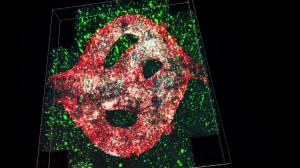Cancer patients' own cells used in 3D printed tumours to test treatments
 Send a link to a friend
Send a link to a friend
 [August 19, 2021]
TEL AVIV (Reuters) - Researchers
have used brain cancer patients' own cells in a form of 3D printing
material to make a model of their tumour to test the efficacy of
potential treatments before using them for real inside the body. [August 19, 2021]
TEL AVIV (Reuters) - Researchers
have used brain cancer patients' own cells in a form of 3D printing
material to make a model of their tumour to test the efficacy of
potential treatments before using them for real inside the body.
The scientists extract "a chunk" of the tumour from the brain of a
patient with glioblastoma - an aggressive cancer with a very poor
prognosis - and use it to print a model matching their MRI scans, said
Professor Ronit Satchi-Fainaro, who led the research at Tel Aviv
University.
The patient's blood is then pumped through the printed tumour, made with
a compound that mimics the brain, followed by a drug or therapeutic
treatment.
While previous research has used such "bioprinting" to simulate cancer
environments, the Tel Aviv University researchers say they are the first
to print a "viable" tumour.

"We have about two weeks (to) test all the different therapies that we
would like to evaluate (on) that specific tumour, and get back with an
answer - which treatment is predicted to be the best fit,"
Satchi-Fainaro said.
A treatment is deemed promising if the printed tumour shrinks or if it
lowers metabolic activity against control groups.
The research was published on Wednesday in the journal Science Advances.
[to top of second column]
|

Researchers have used brain cancer patients' own cells in a form of
3D printing material to make a model of their tumor to test the
efficacy of potential treatments before using them for real inside
the body.

Glioblastoma is the most common form of brain cancer
in adults. It spreads quickly to other parts of the brain, making it
difficult to treat. Survival is around 40% in the first year after
diagnosis and 17% in the second, according to the American
Association of Neurological Surgeons.
Researchers have often 3D printed tumour models to plan for surgery,
but more recent innovations have focused on bioprinting, which uses
live cells as a sort of ink to build up the layers.
Ofra Benny, who leads similar research at the Hebrew University of
Jerusalem, said the use of a patient's own cells to develop 3D
tumour models could be "a game changer in the field of personalised
medicine".
"The more physiological mimicry you create, the better prediction
you get in terms of how drug treatments will work on the actual
tumour in the patient's body," she said.
(Reporting by Rami Ayyub, Rami Amichay and Rinat Harash; Editing by
Alison Williams)
[© 2021 Thomson Reuters. All rights
reserved.] Copyright 2021 Reuters. All rights reserved. This material may not be published,
broadcast, rewritten or redistributed.
Thompson Reuters is solely responsible for this content. |